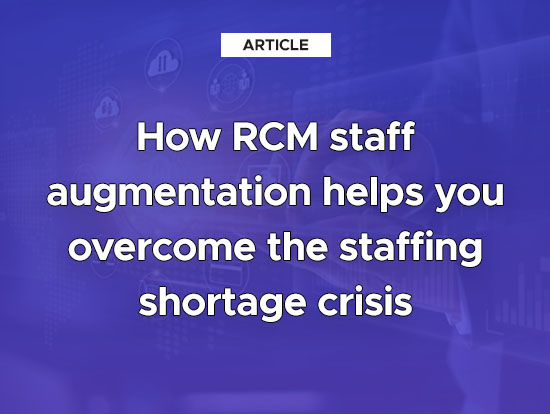The COVID-19 pandemic posed a great threat to the healthcare industry with an unprecedented staffing shortage crisis. From nursing and physician shortages to understaffed paramedic teams, healthcare providers are struggling to meet the increasing demand for quality patient care. Additionally, skilled staff is also a necessity in most practices to maintain and implement practice protocols and ensure seamless practice operations, such as those that involve medical billing.
Therefore, staffing shortages have also affected the revenue cycle management process. Efficient revenue cycle management is important to ensure financial stability, optimize reimbursement processes, and maintain compliance with ever-evolving regulations.
Need for Staff Augmentation
With limited resources and qualified personnel, organizations find it increasingly difficult to navigate the complexities of RCM efficiently. The pandemic forced numerous industries that depended on a manual workforce to face staff shortages.
Thus, healthcare faces a lack of qualified individuals to take on the existing roles in order to bridge the workforce shortage. The pandemic’s unpredictability is the reason behind the increase in the need for skilled personnel in healthcare.
Furthermore, in the field of RCM, a lack of skilled medical billing staff has raised another issue that jeopardizes the very existence of health systems: the enormous backlog of accounts receivable and unfiled claims.
This backlog creates a great deal of pressure on the RCM employees, who remain devoted to overcoming these difficulties. To tackle this issue, healthcare organizations now understand the value of investing in automation and outsourcing tools. Health systems must improve engagement to address the crucial problem of staff burnout. The increase in capacity will likely help lessen the workload of internal RCM workers.
Another contributor to the backlog in the revenue cycle process is physician burnout. Lack of digital tools, the necessity to spend time on clinical documentation and coding, navigating the complexity of government rules, and working longer hours than necessary in healthcare institutions to meet the increased demand are a few of the reasons providers fail to properly manage the revenue cycle. This problem can be solved by hiring more people and funding the digital transformation of the healthcare industry. Digital Revenue Cycle Management software helps automate the entire revenue cycle, leaving no room for errors or backlog.
How RCM Staff Augmentation helps overcome Staffing Shortages
RCM staff augmentation involves adding new workers to a current RCM workforce to boost capacity and offer extra assistance so that the company can have a smooth revenue cycle. RCM staff augmentation can help a healthcare organization in the following ways:
Experienced Staff
Leveraging staff augmentation services helps practices assign tasks and projects to qualified and skilled individuals who are at the peak of their professional careers. This not only opens larger avenues to practice proficiency but also allows healthcare professionals and practice owners to rid themselves of the stress of having to micromanage practice protocols.
Healthcare professionals can, therefore, confide thoroughly in these individuals to get the job done. Not only can this ensure efficiency in RCM operations, but it can also help maximize reimbursement for the practice.
Reduced Costs
If practices require a particular job position to be filled for a short period of time or at regular intervals, hiring someone permanently is not a cost-effective solution.
Staff augmentation services allow healthcare professionals to assign tasks to individuals on a need-only basis. Since the Affordable Care Act allows even a single full-time employee to cause financial strain on healthcare practices, staff augmentation can help mitigate this consequence.
Staff salary, benefits, and tax expenses can cost substantially; therefore, the service allows practice owners to engage professionals with individuals only during crucial periods of need. This is therefore a cost-effective alternative to hiring employees full-time at the practice.
Enhance Viewpoint
Allowing a new member to enter the current practice workforce allows practice owners to gain a fresh perspective on their practice outlook through the ideas and points of view of the new staff.
This can not only help improve the current practice system, but it can also help remove practice inefficiencies and create a more productive working space for both the former and new practice staff.
Practice owners should allow new short-term employees to voice their opinions and create an environment to cultivate innovative thinking throughout the practice. Eventually, this can streamline medical billing workflows for a more smooth-running practice.
Conclusion
Undoubtedly, staffing shortages in the healthcare industry are a challenge that is here to stay. However, as the immediate employment of manpower is insufficient to fill this gap, the healthcare industry depends on technology and innovation to meet the needs of the labor shortage.
Consequently, practicing revenue cycle management requires immediate attention. RCM staff augmentation serves as a powerful tool to overcome these challenges, providing practice owners with talented staff for a more streamlined and effective RCM process that is bound to multiply reimbursements for financial success.




